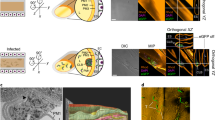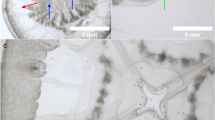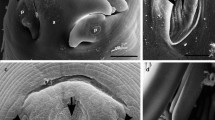Abstract
I HAVE recently demonstrated1 that penetration of Fasciola hepatica into Limnaea truncatula is a brief but elaborate process which involves the successful attachment of the miracidium to the snail, seemingly by suctorial adhesion, and the production of a secretion which cytolyses the integument of the snail in a circumscribed area underlying the anterior non-ciliated pit of the larva. Not until the snail's epithelium has been perforated by cytolytic action does the larval trematode thrust itself into the snail's body. By the time these preparations for entry have been completed, the miracidium has cast off its ciliated epithelium, so that although it is the miracidium which attacks the snail, it is the young sporocyst which enters the snail's body.
This is a preview of subscription content, access via your institution
Access options
Subscribe to this journal
Receive 51 print issues and online access
$199.00 per year
only $3.90 per issue
Buy this article
- Purchase on Springer Link
- Instant access to full article PDF
Prices may be subject to local taxes which are calculated during checkout
Similar content being viewed by others

References
Dawes, Ben, Nature, 184, 1334 (1959).
Hubendick, B., K. Svenska Vetenskapsakad. Handl., 3, 1 (1951).
Kendall, S. B., and Parfitt, J. W., Nature, 171, 1164 (1953).
Author information
Authors and Affiliations
Rights and permissions
About this article
Cite this article
DAWES, B. Penetration of Fasciola gigantica Cobbold, 1856 into Snail Hosts. Nature 185, 51–53 (1960). https://doi.org/10.1038/185051b0
Issue Date:
DOI: https://doi.org/10.1038/185051b0
Comments
By submitting a comment you agree to abide by our Terms and Community Guidelines. If you find something abusive or that does not comply with our terms or guidelines please flag it as inappropriate.


